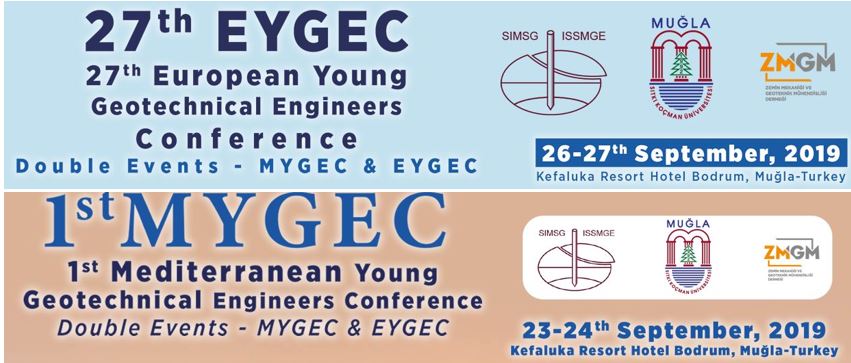27ª Conferencia Europea de Jóvenes Ingenieros Geotécnicos (EYGEC)
1er Congreso Mediterráneo de Jóvenes Ingenieros Geotécnicos
Bodrum (Turquía), 23-27 de septiembre de 2019
ÍNDICE DE ARTÍCULOS:
1.- Bearing capacity: correction factors in soil and in rock mechanics. Ana Teresa Santos de Alencar.
2.- Socket roughness effect on side shear resistance prediction of rock-socketed piles. José Gregorio Gutiérrez Chacón.
1.- «Bearing capacity: correction factors in soil and in rock mechanics.»
Autor: Ana Teresa Santos de Alencar.
Resumen:
In the field of soil mechanics, the calculation of the bearing capacity is well developed, there are various correction coefficients published by different authors that are used to take into account diverse hypothesis regarding self-weight, foundation type, foundation roughness, etc. However, in rock mechanics the application of these correction coefficients developed in soil mechanics can lead to erroneous results, so it is still necessary to carry out more research in order to know further the influence of multiple parameters of the rock mass on the bearing capacity of shallow foundation to estimate it with more accuracy applying different correction factors. Based on the limitations of different analytical solutions for the estimation of the bearing capacity of shallow foundation on rock mass, the numerical modeling of the shallow foundation by finite difference code FLAC is performed over a great number of cases. The purpose of that numerical modelling is to study the influence of geometrical and geotechnical parameters (foundation width, rock type, uniaxial compressive strength and geological strength index) on the bearing capacity of foundations on rock mass under different hypotheses of the self-weight of material, the footing shape and the roughness of the base interface. In this paper a summary of a comparison between the influence of different correlation coefficients in soils and rocks is presented in order to determine which parameter is more conditioning in each type of material and the mechanical behavior observed, analyzing quantitatively those differences as well.
DESCARGAR ARTÍCULO (Solo para socios)
2.- «Socket roughness effect on side shear resistance prediction of rock-socketed piles.»
Autores: José Gregorio Gutiérrez Chacón.
Resumen:
Rock-socketed piles have been extensively employed to receive and transmit large concentrated loads to deeper stronger materials. Although the load transfer mechanism combines base and side resistances, the contribution of side shear resistance is often crucial, as it is usually mobilized at much lower strains (or pile settlements) than base resistance. The side shear resistance of rock-socketed piles has usually been estimated usingrecommendations from codes and standards, or using local knowledge obtained from full-scale static load tests performed in similar ground. There are also empirical formulations as a function of the uniaxial compressive strength of the intact rock. However, this approach neglects the influence of other important aspects such as the effect of roughness at the rock-pile interface, and this factor is not always being considered in current design practices. The aim of this work is to examine the socket roughness effect on side shear resistance of rock[1]socketed piles. To do that, DEM2D numerical models of direct shear tests, and DEM3D numerical models of rock-socketed piles with different degrees of socket roughness are employed. DEM results suggest that socket roughness is an important factor that significantly increases the load capacity and stiffness of rock-socketed piles




